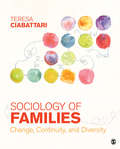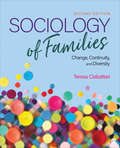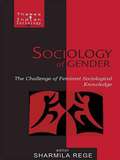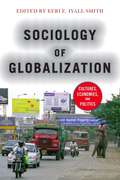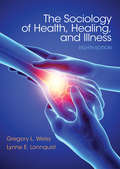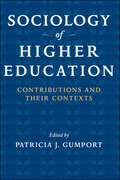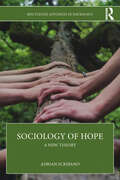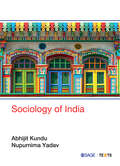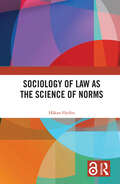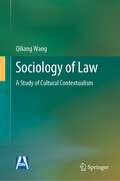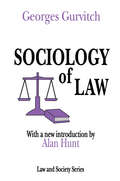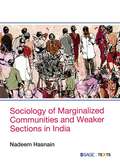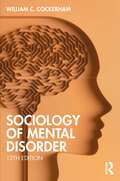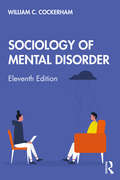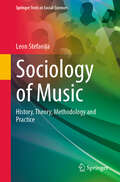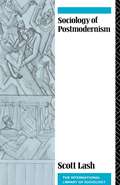- Table View
- List View
Sociology of Families: Change, Continuity, and Diversity
by Professor Teresa CiabattariThe family patterns seen in recent decades—cohabitation, divorce, nonmarital childbearing, same-sex marriage and childrearing—can seem like radical changes from the past. But upon closer examination, many are consistent with broader trends that have been going on for centuries. Sociology of Families: Change, Continuity, and Diversity considers this tension between change and continuity, situating families in a social, historical, and economic context, and emphasizing how these contexts create family diversity and inequality. By incorporating diverse family structures into each chapter, author Teresa Ciabattari has written a text that challenges idealized assumptions about how families should be, and instead explores the complex realities of how families actually are.
Sociology of Families: Change, Continuity, and Diversity
by Professor Teresa CiabattariThe family patterns seen in recent decades—cohabitation, divorce, nonmarital childbearing, same-sex marriage and childrearing—can seem like radical changes from the past. But upon closer examination, many are consistent with broader trends that have been going on for centuries. Sociology of Families: Change, Continuity, and Diversity considers this tension between change and continuity, situating families in a social, historical, and economic context, and emphasizing how these contexts create family diversity and inequality. By incorporating diverse family structures into each chapter, author Teresa Ciabattari has written a text that challenges idealized assumptions about how families should be, and instead explores the complex realities of how families actually are.
Sociology of Families: Change, Continuity, and Diversity
by Teresa CiabattariSociology of Families: Change, Continuity, and Diversity offers students an engaging introduction to sociological thinking about contemporary families in the United States. By incorporating discussions of diversity and inequality into every chapter, author Teresa Ciabattari highlights how structures of inequality based on social divisions such as gender, race, and sexuality shape the institution of the family. The Second Edition has been updated to include the most recent data and statistics, expanded coverage of childhood and parenting, and a new chapter on family violence. Included with this text The online resources for your text are available via the password-protected Instructor Resource Site..
Sociology of Families: Change, Continuity, and Diversity
by Teresa CiabattariSociology of Families: Change, Continuity, and Diversity offers students an engaging introduction to sociological thinking about contemporary families in the United States. By incorporating discussions of diversity and inequality into every chapter, author Teresa Ciabattari highlights how structures of inequality based on social divisions such as gender, race, and sexuality shape the institution of the family. The Second Edition has been updated to include the most recent data and statistics, expanded coverage of childhood and parenting, and a new chapter on family violence. Included with this text The online resources for your text are available via the password-protected Instructor Resource Site..
Sociology of Gender
by Sharmila RegeThis invaluable reader maps the contributions made by feminist scholars towards engendering mainstream sociological discourse in India. It covers a broad range of issues relating to the lifespan of women in different social institutions such as the family, school and the workplace. This book is one of the Indian Sociological Society: Golden Jubilee Volumes.
Sociology of Globalization
by Keri E. Iyall SmithA rich collection of diverse voices,Sociology of Globalizationexamines the processes of globalization as well as its impact on people around the world. It looks beyond the headlines, stereotypes, and hype and features a balanced selection of classic scholarship and theory, cutting-edge research, and engaging journalism. Key pieces from prominent scholars, journalists, and theorists will resonate with students, stretch the classroom into their daily lives, and give the study of globalization concrete meaning. Each of three sections-culture, economy, and politics-begins with an original introduction from the editor which familiarizes readers with essential themes and concepts and provides necessary context for the readings that follow. Useful resources for further research, including websites, films, and class exercises, are also provided to exemplify and add relevance to major topics. Accessible and expansive, this is the ideal primary reader or supplement for undergraduate courses on the sociology of globalization.
Sociology of Globalization
by Keri E. Iyall SmithA rich collection of diverse voices, Sociology of Globalization examines the processes of globalization as well as its impact on people around the world. It looks beyond the headlines, stereotypes, and hype and features a balanced selection of classic scholarship and theory, cutting-edge research, and engaging journalism. Key pieces from prominent scholars, journalists, and theorists will resonate with students, stretch the classroom into their daily lives, and give the study of globalization concrete meaning. Each of three sections--culture, economy, and politics--begins with an original introduction from the editor which familiarizes readers with essential themes and concepts and provides necessary context for the readings that follow. Useful resources for further research, including websites, films, and class exercises, are also provided to exemplify and add relevance to major topics. Accessible and expansive, this is the ideal primary reader or supplement for undergraduate courses on the sociology of globalization.
Sociology of Health, Healing, and Illness
by Gregroy L. Weiss Lynne E. LonnquistA comprehensive presentation of the major topics in medical sociology. The Sociology of Health, Healing, and Illness, 8/e by Gregory L. Weiss and Lynne E. Lonnquist provides an in-depth overview of the field of medical sociology. The authors provide solid coverage of traditional topics while providing significant coverage of current issues related to health, healing, and illness. Readers will emerge with an understanding of the health care system in the United States as well as the changes that are taking place with the implementation of The Affordable Care Act.
Sociology of Higher Education: Contributions and Their Contexts
by Patricia J. GumportIn this volume, Patricia Gumport and other leading scholars examine the sociology of higher education as it has evolved since the publication of Burton Clark's foundational article in 1973. They trace diverse conceptual and empirical developments along several major lines of specialization and analyze the ways in which wider societal and institutional changes in higher education have influenced this vital field of study.In her own chapters, Gumport identifies the factors that constrain or facilitate the field's development, including different intellectual legacies and professional contexts for faculty in sociology and in education. She also considers prospects for the future legitimacy and vitality of the field.Featuring extensive reviews of the literature, this volume will be invaluable for scholars and students of sociology and higher education.
Sociology of Higher Education: Contributions and Their Contexts
by Patricia J. Gumport&“Outstanding . . . it presents a comprehensive state of the field, and it explores the role of sociological research in guiding higher education practice.&” —Choice In this volume, Patricia Gumport and other leading scholars examine the sociology of higher education as it has evolved since the publication of Burton Clark&’s foundational article in 1973. They trace diverse conceptual and empirical developments along several major lines of specialization and analyze the ways in which wider societal and institutional changes in higher education have influenced this vital field of study. In her own chapters, Gumport identifies the factors that constrain or facilitate the field&’s development, including different intellectual legacies and professional contexts for faculty in sociology and in education. She also considers prospects for the future legitimacy and vitality of the field. Featuring extensive reviews of the literature, this volume will be invaluable for scholars and students of sociology and higher education.
Sociology of Hope: A New Theory (Routledge Advances in Sociology)
by Adrian ScribanoThis book explores the sociology of hope. It presents an overview of the “state of the art” of hope in sociology and proposes a new basic theory of hope linked to the classical theoretical traditions of sociology, to the perspective of its founding women, and to the reconstruction of the contributions of the theories of revolution, utopia, social change, and collective action.In an attempt to understand the sociology of hope as a critical theory and a science of life, this book proposes the central elements in theoretical and epistemic terms for establishing connections between ethics, aesthetics, politics of knowledge, and their current strong modifications in the study of society. As such, the book will appeal to scholars and students interested in emotions, particularly from the disciplines of sociology, anthropology, political science, and psychology.
Sociology of India
by Abhijit Kundu Nupurnima YadavThis new textbook traces the evolution and development of sociology as a field of study in India and enumertes the key sociological aspects of the Indian society. This new textbook enumerates a sociological perspective by tracing the development and rise of sociology as a subject in India. Through an organized thematic understanding of the sociological aspects of Indian society, this textbook aims at analysing the continuity between the past and the present. It also brings into light the new challenges and concepts gaining ground for a fresh appraisal of the Indian society. The book refers extensively to research works beyond the disciplinary boundary of sociology to help develop a lucid yet critical understanding of a multifaceted society. Fulfilling the core requirements of UGC CBCS guidelines for undergraduate students of sociology, the book will prove to be a useful companion for students of political science, history and social work, and civil service aspirants. Key Features: • Accessible approach to topics - providing conceptual clarity, without diluting the analytical thrust • Provides a holistic understanding of each topic, covering information on major works on each theme • Content resourced on the most updated references on Indian sociology • Each chapter aided by insightful pedagogical features such as learning outcomes, key terms, glossary and points for classroom discussion
Sociology of Indian Society EM Textbook for 2nd PUC (Revised 2021)
by Department of Pre-University Eduction Malleshwaram BangaloreIt is an Educational book for 2nd PUC Sociology of Indian Society EM Textbook English Medium Students.
Sociology of Interdisciplinarity: The Dynamics of Energy Research
by Chris Foulds Antti SilvastThis Open Access book builds upon Science and Technology Studies (STS) and provides a detailed examination of how large-scale energy research projects have been conceived, and with what consequences for those involved in interdisciplinary research, which has been advocated as the zenith of research practice for many years, quite often in direct response to questions that cannot be answered (or even preliminarily investigated) by disciplines working separately. It produces fresh insights into the lived experiences and actual contents of interdisciplinarity, rather than simply commentating on how it is being explicitly advocated. We present empirical studies on large-scale energy research projects from the United Kingdom, Norway, and Finland. The book presents a new framework, the Sociology of Interdisciplinarity, which unpacks interdisciplinary research in practice. This book will be of interest to all those interested in well-functioning interdisciplinary research systems and the dynamics of doing interdisciplinarity, including real ground-level experiences and institutional interdependencies.
Sociology of Law as the Science of Norms (Studies in the Sociology of Law)
by Håkan HydénThis book proposes the study of norms as a method of explaining human choice and behaviour by introducing a new scientific perspective. The science of norms may here be broadly understood as a social science which includes elements from both the behavioural and legal sciences. It is given that a science of norms is not normative in the sense of prescribing what is right or wrong in various situations. Compared with legal science, sociology of law has an interest in the operational side of legal rules and regulation. This book develops a synthesizing social science approach to better understand societal development in the wake of the increasingly significant digital technology. The underlying idea is that norms as expectations today are not primarily related to social expectations emanating from human interactions but come from systems that mankind has created for fulfilling its needs. Today the economy, via the market, and technology via digitization, generate stronger and more frequent expectations than the social system. By expanding the sociological understanding of norms, the book makes comparisons between different parts of society possible and creates a more holistic understanding of contemporary society. The book will be of interest to academics and researchers in the areas of sociology of law, legal theory, philosophy of law, sociology and social psychology.
Sociology of Law: A Study of Cultural Contextualism
by Qiliang WangThis book, based on extensive ethnographic material, analyzes the complex relationships between the law and various social controls, helping to answer the question of how social order is formed. Formal law exists in a web of complex structures and meanings. Accordingly, legal study must take into account multiple types of order, allowing us to understand in depth the strengths and weaknesses, reasonable and absurdity, and successes and failures of the law. In addition, the interactions of numerous actors shape the structure and context of the law. Exploring these aspects—while also highlighting diverse informal/non-state norms that influence day-to-day social practices, and which have never been replaced by modern laws—the book offers an insightful resource for all readers who are interested in the practice of Chinese law or in the connections between culture, society, and the law.
Sociology of Law: Towards A Sociology Of Law As Governance (Law And Society Ser.)
by Norman K. Denzin Georges GurvitchGeorges Gurvitch occupies an interesting position in the development of the sociology of law. In the period immediately preceding its quantitative expansion, he produced an explicitly conceived systematic theoretical intervention. What is particularly significant about Gurvitch's Sociology of Law at first appears as a contradiction. His work has had very little lasting impact on developments within the field of the sociology of law. At best, his existence is occasionally footnoted, but he engendered no great controversy or debate, nor does he have any active contemporary "disciples." Despite this lack of attention, Gurvitch work provides a concentrated expression of the theoretical problems that beset the field. The core of Gurvitch's sociology of law is at root a continuation of the efforts, apparent in the work of Max Weber, to resolve or integrate the dualism which is so markedly affecting law. It is the apparent dualism between law as a positive institution resting upon a framework of social power, while at the same time being a system of values or norms having some compelling internal strength and validity. Gurvitch's Sociology of Law shines as a beacon in the ongoing quest for a transformative vision of law. The new introduction by Alan Hunt discusses Gurvitch's place in the history of the sociology of law and the context in which his works should be placed. It also features a brief biography of the sociologist as well as a discussion of the central features of Gurvitch's sociology. This book will be of interest to students of sociology and law.
Sociology of Marginalized Communities and Weaker Sections in India
by Nadeem HasnainFirst-ever textbook dealing with the marginalized communities and weaker sections of the Indian society through historical and contemporary societal perspectives. Marginalized and weaker sections of India such as scheduled castes, OBCs and scheduled tribes, and minorities -- linguistic, religious and sexual -- have been studied under different disciplines over the years, especially sociology, social anthropology, social work and political science. This book comprehensively brings together the major findings and debates around all the marginalized, socially excluded and weaker sections of the Indian society. Starting from the issues of definition and conceptualization, it goes on to provide various strands of their society, culture, problems and the role of the State. It provides historical perspective backed by the contemporary situation and emerging social changes among these communities. Written in a lucid manner, the textbook aims to reach and impact readers who may not have prior academic exposure to this subject area. Key Features: • Adopts interdisciplinary approach for the benefits of the students of sociology, anthropology, social work and political science • Offers clear and accessible analysis of theories, concepts and issues involved • Includes latest research and empirical studies supplemented by a variety of relevant opinions and debates
Sociology of Mental Disorder
by William C. CockerhamThe tenth edition of Sociology of Mental Disorder presents the major issues and research findings on the influence of race, social class, gender, and age on the incidence and prevalence of mental disorder. The text also examines the institutions that help those with mental disorders, mental health law, and public policy. Many important updates are new to this edition: -More first-person accounts of individuals who suffer from mental illness are included. -The new DSM-5 is now thoroughly covered along with the controversy surrounding it. -A new section on on social class and its components. -Updated assessment of the relationship between mental health and gender. - A revised and in-depth discussion of mental health and race. -New material on public policy, mental disorder, and the Affordable Health Care Act. -Updates of research and citations throughout.
Sociology of Mental Disorder
by William C. CockerhamThe twelfth edition of the Sociology of Mental Disorder presents the major issues and research findings on the influence of race, social class, gender, and age on the incidence and prevalence of mental disorders. The text also examines the institutions that help those with mental disorders, mental health law, and public policy. Many important updates are new to this edition: The mental health effects of the COVID-19 pandemic are examined. Aging and mental health is discussed in more detail. Updated review of gender differences in mental disorder. A revised and more in-depth discussion of mental health and race. Problems in the community care of the mentally ill are covered. Updates of research and citations throughout. Blending foundational concepts and sociological perspectives on mental health issues with newer studies and accounts in an accessible and authoritative survey of the field, the new edition of Sociology of Mental Disorder remains an essential text and an invaluable resource for students and scholars.
Sociology of Mental Disorder (Mysearchlab Series For Sociology Ser.)
by William C. CockerhamThe eleventh edition of Sociology of Mental Disorder presents the major issues and research findings on the influence of race, social class, gender, and age on the incidence and prevalence of mental disorder. The text also examines the institutions that help those with mental disorders, mental health law, and public policy. Many important updates are new to this edition: -DSM-5 is thoroughly covered along with the controversy surrounding it. -Updated review of the relationship between mental health and gender. - A revised and more in-depth discussion of mental health and race. -Problems in public policy toward mental disorder are covered. -International trends in community care are reviewed. -Updates of research and citations throughout.
Sociology of Music: History, Theory, Methodology and Practice (Springer Texts in Social Sciences)
by Leon StefanijaThe textbook provides students with insight into and overview of the basics of social research on music. It addresses the Who, What, When, Where, Why, How of music research through four perspectives from the sociological study of music: a historical survey of the social study of music (when), theoretical points of view (what), and methodological (how), and pragmatic aspects (who, why & how). The other Ws (where and why) are included within the four main perspectives. The four perspectives – history, theory, methodology, and practice – are complementary. Some of the names included in the theory and practice of music are also listed as a part of the history of music sociology, and vice versa. In this way, the book encompasses what Howard S. Becker has conceptualized as an art world, Kurt Blaukopf as musical practice, and Christopher Small as musicking. Covering all the relevant details yet concise in structure, this book is ideal for students of the sociology of music, musical education, musicology and of arts and aethestics.
Sociology of North American Sport
by Stanley EitzenExploration of North American sporting rituals through the lens of sociology.
Sociology of Postmodernism (International Library of Sociology)
by Dr Scott LashFirst published in 1990. Routledge is an imprint of Taylor & Francis, an informa company.
Sociology of Religion (Routledge Library Editions: Sociology of Religion #16)
by Joachim WachThis book, first published in 1947, presents the then-new subject of sociology of religion in systematic and historical theology and in the science of religion, in political theory and the social sciences, in philosophy and psychology, in philology and anthropology. Its intention is to bridge the gulf between the study of religion and the social sciences, an exercise that draws strongly upon cultural anthropology.
